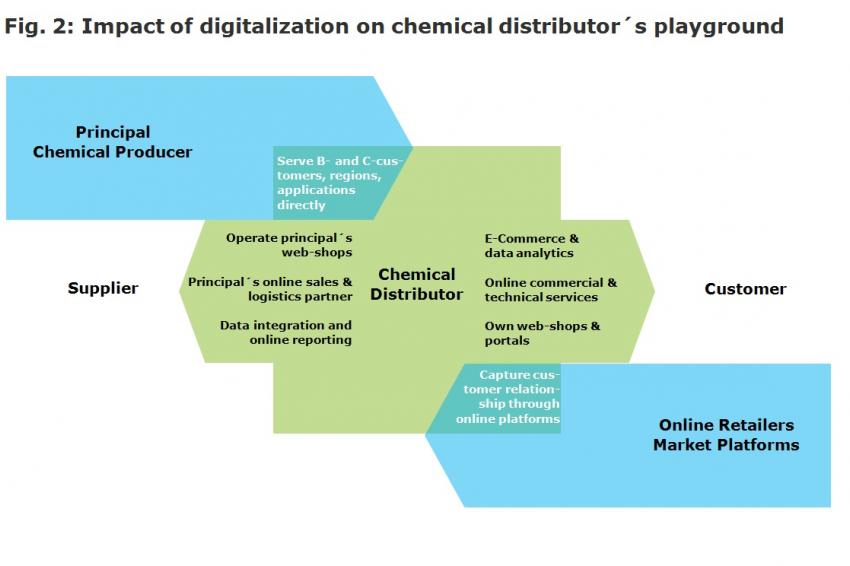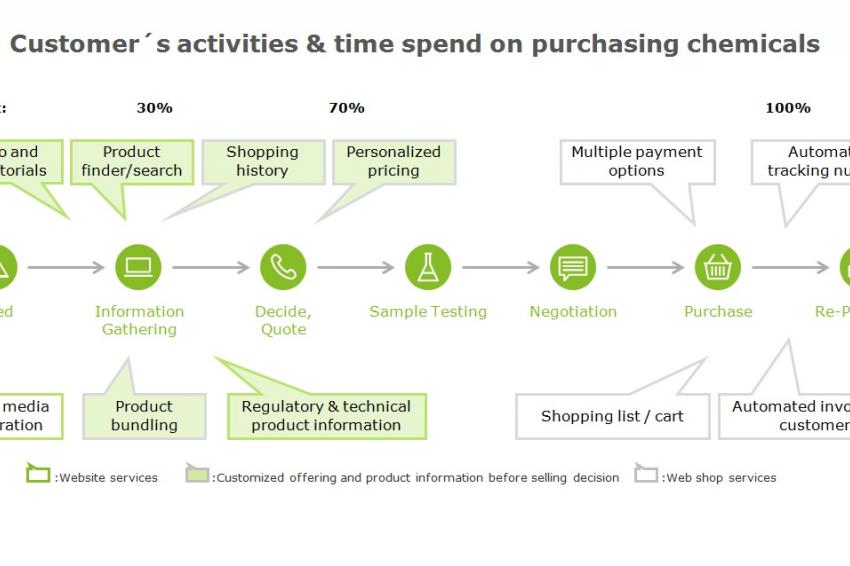Digitalization – Challenges and Opportunities
How Can Chemical Distributors Capture the Opportunities and Mitigate the Risks of Digitalization?
Will these digitalization trends be transformational or disruptive? Bear those trends more challenges or opportunities for Chemical Distributors? Who will be the winners and losers among the Chemical Distributors? There are many questions that demand answers.
Digitalization - Transformational or Disruptive?
Since about 2010 all major chemical companies have started to launch digitalization projects. More than three quarters of those projects aim at cutting costs and achieving a next level of „Operational Excellence“. Plants are run remotely, maintenance is increasingly done preventively and predictively, sensors and actors with data analytics are used to increase yields and selectivity in chemical processes, track-and-trace systems increase supply chain efficiency and Enterprise Resource Planning (ERP)-integration lowers administrative costs jointly for the producer and its large suppliers and customers. Robot Process Automation (RPA) is increasingly used to substitute repetitive, standardized tasks, which will ultimately result in a re-shoring of general and administrative tasks. Take for instance procurement: Invoice verification with or without purchase order, purchase order creation, maintenance of master data, intercompany reconciliation and netting, verification of tax ID numbers and creditor interaction, contract management, supplier payment authorization, creating reports and much more can be executed three times faster, much cheaper and most importantly much more accurately with RPA than doing those processes manually.
At the same time ERP systems are moving into the cloud, offering a new level of transparency and ad hoc information, that is increasingly needed to do better demand forecasts, have access to current business information and make better management decisions.
On the customer side digitalization leads more and more to a “dematerialization”. The increasing functionality and performance of chemical products combined with a stagnating demand for materials in Western Europe leads to a declining demand for, often very different, chemical products. Some applications can be partly or fully digitalized (e.g. textile print instead of dyeing textiles, OLEDs instead of colored pigments, 3D print/additive manufacturing instead of central production).
Most of the trends which are driven by the chemical industry are transformational and chemical companies move into the digital world step by step. WIFI costs for an old, depreciated asset base, cyber security and data integrity concerns, missing vertical and horizontal integration and lack of standards are typical concerns that make digitalization at chemical companies transformational and not disruptive. However, the customer, consumer and regulatory driven trends are sometimes disruptive to the chemical and chemical distribution industries, like electric drive trains in cars, digital farming, individual self-medication, modular building constructions, and the changing demand in an increasingly circular economy. This disruption leads to winners and losers among the chemical and Chemical Distribution players, depending on their portfolio of products and solutions.
Digitalization – Challenges or Opportunities?
The digitalization challenge for a chemical distributor can be twofold:
- Forward integrating principals: Operational Excellence in supply chain & logistics as well as marketing & sales allows principals to effectively reach B- and C-customers, -regions and –application areas that they have previously handed over to chemical distributors. Track-and-trace systems, automation, and predictive demand forecasting as well as online ordering and order history, customized delivery, omni-channel customer access, e-commerce and teleservices (commercial and technical) can make at least some of the chemical distributor functionality and services obsolete.
- New online retailers capturing the customer relationship: Alibaba, Amazon Business, Ebay, as well as newly created chemical trading or market platforms (e.g. Bizongo, Comivo, Chembargains, ChemNet, Chemocart, HMX, Isuwang, Kemgo, Kinnek, Molbase, PolymerMarketplace) supported by significant investments of venture capital funds are currently exploring the opportunities to disrupt the chemical or chemical distributor relationship with their respective customers. A current Deloitte survey among more than 200 customers of a specialty chemicals distributor shows that online services are increasingly expected and requested by customers. As a surprise to us we learnt that 70% of customer´s purchasing time is spent on product search and quotations (30% on product search, finding, and bundling and 40% on shopping history, regulatory and technical product information). Only 30% of customer time is spend on sample testing, negotiation, purchase and re-purchase.
New Digital challengers are focusing on exactly those 70% of customer time. They try to make product search and quoting easier, more convenient and more efficient.
Chemical distributors that have done their homework and built a strong position in the analogue world need not be afraid of digitalization, but should use it to run web shops and portals for their principals, move to online services and offer track-and-trace solutions. Those chemical distributors that do not have a proprietary, complementary and full product portfolio in specialty chemicals or lack logistically advantaged local asset structures (tank farms, bulk storage, truck fleet) in bulk chemicals will probably further lose momentum and suffer. This is especially true for low value adding services, like agent, trading and drop shipping (Streckengeschäfte) businesses as well as for large volume, standardized products and standardized terms and conditions. Many chemical distribution services, products and delivery terms and conditions are however customized and thus not easily substituted by standard offerings. This strong customization will give also smaller chemical distributors a good opportunity to live profitably with digitalization, as long as they fulfil those individual customer needs and serve their customers well.
Digitalization – Winners & Losers?
In summary digitalization brings transparency and agility that will accelerate the separation between well run and differentiated chemical distribution winners and less well run losers.
This digital divide will displace low value adding, standardized products and services of the latter. It will support those Chemical Distributors that have done their homework to build differentiating, profitable and sustainable principal and customer relationships and provide tailored services and solutions. In order to stay a winner those companies need to complement their operating and business models by e-commerce, online services, and data analytics. The strong and big ones should attempt to control full customer contact and promote selected producers. The smaller ones should manage customer contacts on behalf of the respective principals. And the really small ones should continue to serve their customers with individualized services and integrated solutions to better fulfil their individual needs. This is how chemical distributors of all sizes can capture the opportunities and mitigate the risks of digitalization.








